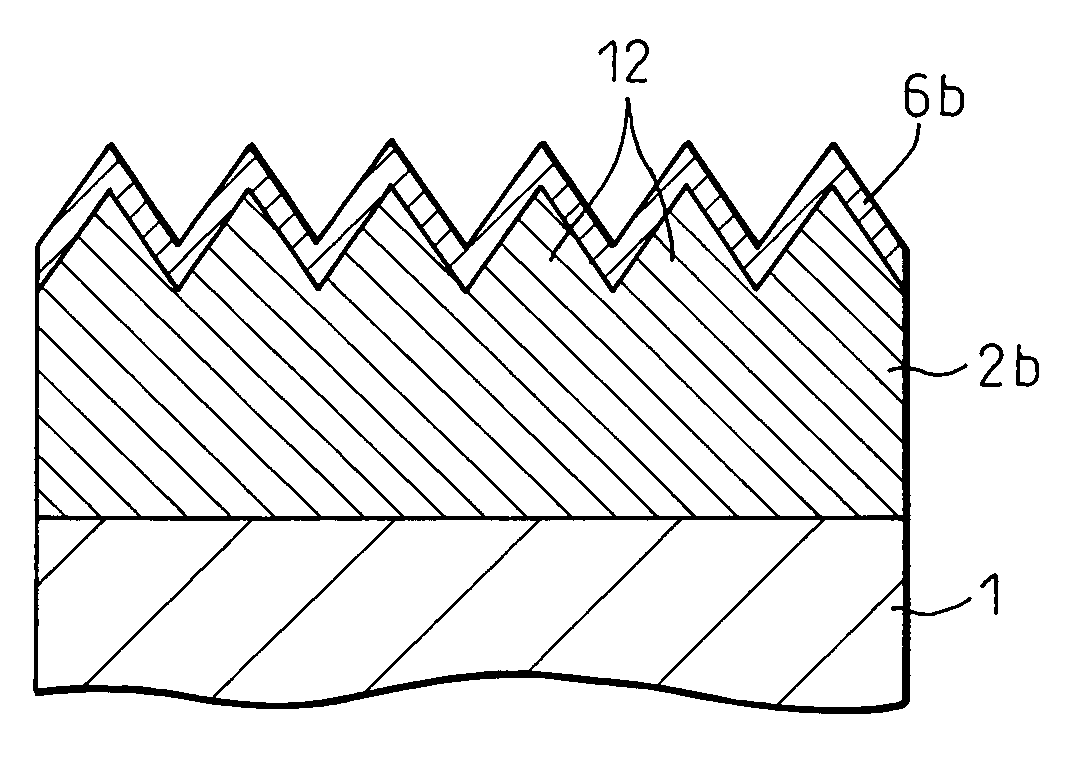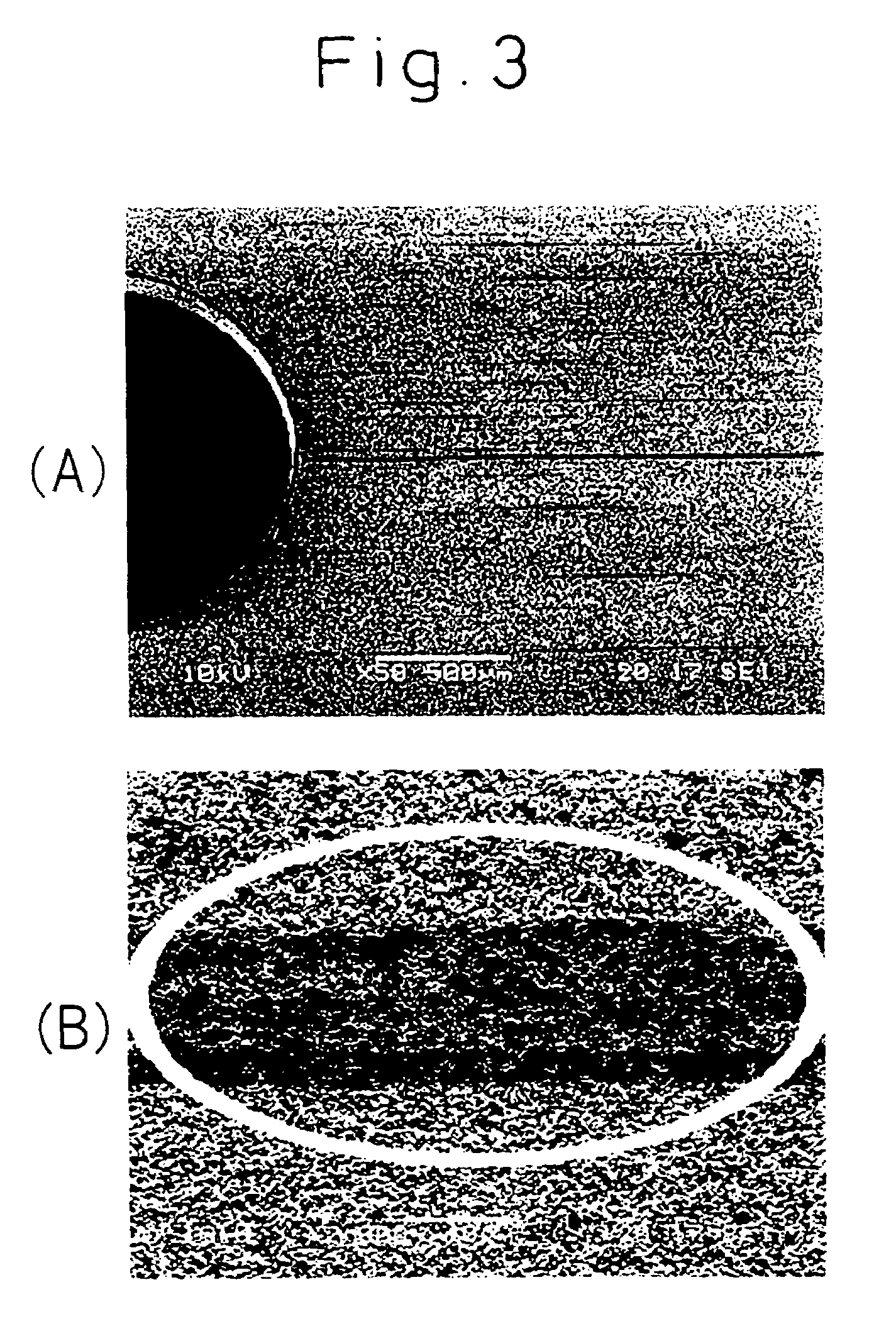Packaging component and semiconductor package
a technology of packaging components and semiconductors, applied in semiconductor/solid-state device details, semiconductor devices, multi-unit cooking vessels, etc., can solve the problems of deterioration of adhesion between lead frame or another packaging component, deterioration of deterioration of good adhesion between ni-plated layer and sealing resin with time, etc., to achieve excellent heat conduction, excellent electric conduction, and easy work
- Summary
- Abstract
- Description
- Claims
- Application Information
AI Technical Summary
Benefits of technology
Problems solved by technology
Method used
Image
Examples
example 1
Formation of a Rough-Surface Ni-Plated Layer:
[0119]A copper alloy (trade name: CDA194) containing a trace amount of iron (Fe) was used as a starting material, and the surface on one side thereof was electroplated with nickel to form rough-surface Ni-plated layers at different thicknesses, thereby preparing the following four samples.
[0120]
Sample A:layer thickness of 0.5 μmSample B:layer thickness of 1.0 μmSample C:layer thickness of 3.0 μmSample D:layer thickness of 5.0 μm
[0121]The composition of the electroplating bath and the plating conditions used in this example were as follows: Nickel chloride plating bath:
[0122]
Nickel chloride75 g / LSodium thiocyanate15 g / LAmmonium chloride30 g / LpH:about 4.5 to 5.5Bath temperature:normal temperature (about 25° C.)Cathode current density:about 1 to 3 A / cm2
[0123]The samples A to D having lusterless surface each was:[0124](A) Observed for their surface states by using a scanning electron microscope (SEM, ×10,000),[0125](B) Observed for their cros...
example 2
Formation of a Smooth-Surface Ni-Plated Layer:
[0132]A copper alloy (trade name: CDA194) containing a trace amount of iron (Fe) was used as a starting material, and the surface on one side thereof was electroplated with nickel to form smooth-surface Ni-plated layers at different thicknesses, thereby preparing the following four samples.
[0133]Sample I: layer thickness of 0.5 μm
[0134]Sample II: layer thickness of 1.0 μm
[0135]Sample III: layer thickness of 3.0 μm
[0136]Sample IV: layer thickness of 5.0 μm
[0137]The composition of the electroplating bath and the plating conditions used in this example were as follows: Nickel sulfamate plating bath:
[0138]
Nickel sulfamate320 g / LBoric acid 30 g / LNickel bromide 10 g / LpH:about 3.0 to 4.0Bath temperature:about 30 to 50° C.Cathode current density:about 3 to 30 A / cm2
[0139]The samples I to IV having matte surface each was:[0140](A) Observed for their surface states by using a scanning electron microscope (SEM, ×10,000),[0141](B) Observed for their ...
example 3
Measurement of the Cup Shear Strength:
[0153]In this example, the samples A to D prepared in Example 1 and the samples I to IV prepared in Example 2 were measured for their cup shear strengths according to the procedure specified under SEMI Standard G69-0996 to evaluate the adhesion of the resin to the rough-surface Ni-plated layer and to the smooth-surface Ni-plated layer.
[0154]First, cups 21 in the shape of a circular truncated cone having a height h of 3 mm, a bottom diameter d1 of 3.568 mm, an upper diameter d2 of 3 mm and a surface area of 10.2 mm2 as illustrated in FIG. 26A were molded by using the following two types of sealing resins:
[0155]Sealing resin A—OCN type (produced by “N” Company)
[0156]Sealing resin B—BNL type (produced by “H” Company)
[0157]The cup 21 was placed on a sample (lead frame) 1 as illustrated in FIG. 26(B) and was heated (post-cured) at 175° C. for 6 hours.
[0158]After the cup 21 was cured and formed upon heating on the sample 1, a gauge (not shown) was pus...
PUM
| Property | Measurement | Unit |
|---|---|---|
| Thickness | aaaaa | aaaaa |
| Electrical conductivity | aaaaa | aaaaa |
| Structure | aaaaa | aaaaa |
Abstract
Description
Claims
Application Information
 Login to View More
Login to View More - R&D
- Intellectual Property
- Life Sciences
- Materials
- Tech Scout
- Unparalleled Data Quality
- Higher Quality Content
- 60% Fewer Hallucinations
Browse by: Latest US Patents, China's latest patents, Technical Efficacy Thesaurus, Application Domain, Technology Topic, Popular Technical Reports.
© 2025 PatSnap. All rights reserved.Legal|Privacy policy|Modern Slavery Act Transparency Statement|Sitemap|About US| Contact US: help@patsnap.com



